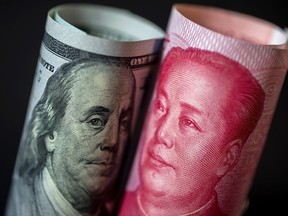The Chinese economy has headed into a severe slowdown, with its economy entering deflationary terrain and the property sector remaining in crisis mode. The economic downfall will weigh negatively on the global economy, primarily through trade channels on countries with a high dependency on China.
Economy
David Rosenberg: Who will suffer the spillover from China’s economic downfall

With two-way trade making up 40 per cent of gross domestic, slumping exports/imports will inevitably have ripple effects on China’s trading partners. The United States, Japan and South Korea are the top three countries that have the largest trade inflow/outflow with China. With the U.S., we already see evidence of the friend-shoring theme — moving away from China and shifting the factory orders to India, Vietnam, Mexico and Brazil (winners from China’s economic descent). And as the producer price index (PPI) and export prices in China remain in deflationary terrain, this will help China’s trading partners (mainly the U.S.) in their battle against inflation.
The commodity sector is also highly dependent on China as it accounts for half the world’s basic materials consumption and a quarter of total oil imports. As the property/infrastructure bubble bursts, this will hurt mineral-exporting countries (Brazil, Australia, Peru and Chile) the most. Australia accounts for 56 per cent of total iron ore exports, and Brazil for 18 per cent. And China imports a massive 70 per cent of the world’s iron ore, which is not-so-great news for the Australian economy.
In addition to iron ore, China is also the world’s largest importer of copper. On the exports side, Chile is the largest copper exporter (26 per cent), Peru is the second (15 per cent) and Indonesia the third (10 per cent).
Foreign direct investment in China
Direct investment liabilities (a common measure for foreign direct investment) in China fell to US$4.9 billion in the second quarter — the lowest level in 25 years and down 87 per cent year over year. In the first quarter of 2022, it was standing at US$101 billion, and is now almost down 95 per cent from that level.
The declining foreign investment in China will show itself in the trade numbers as the exports from foreign companies in China are approximately 30 per cent of total Chinese exports. The deteriorating FDI will not show up in the GDP data, but will result in lower profit margins for companies operating in China. The MSCI World with China Exposure index (composed of companies with significant revenue exposure to China) is already down seven per cent month over month.
Countries with larger investments in China will be more sensitive to the economy’s downfall. Singapore has the highest foreign direct investment (as measured by the amounts of contracts utilized) in China, followed by South Korea, Japan, Germany and the U.S. So, when some pundits say “don’t worry about the United States, it doesn’t export much to China,” what is missing from that statement is that the U.S. is in the top five when it comes to foreign direct investment exposure in China. And the companies that operate there with a view towards serving the Chinese economy (and the rest of Asia) are surely going to see a dampening effect on their worldwide profits and from that indirect effect, end up having negative repercussions for the stock market (or at least those companies with footholds in China who will be affected).
Bottom line: the most abrupt spillover effect of the contraction in the property sector and depressed demand in China will be in commodities, mainly copper (down six per cent since the end of July peak). Mineral exporting countries such as Australia, Peru, Chile and Brazil are expected to see their respective currencies and trade balance weaken amid the secular demand downturn in China. As foreign direct investments continue to decline, the outlook is not too bright either for companies operating in China.
Economy
September merchandise trade deficit narrows to $1.3 billion: Statistics Canada

OTTAWA – Statistics Canada says the country’s merchandise trade deficit narrowed to $1.3 billion in September as imports fell more than exports.
The result compared with a revised deficit of $1.5 billion for August. The initial estimate for August released last month had shown a deficit of $1.1 billion.
Statistics Canada says the results for September came as total exports edged down 0.1 per cent to $63.9 billion.
Exports of metal and non-metallic mineral products fell 5.4 per cent as exports of unwrought gold, silver, and platinum group metals, and their alloys, decreased 15.4 per cent. Exports of energy products dropped 2.6 per cent as lower prices weighed on crude oil exports.
Meanwhile, imports for September fell 0.4 per cent to $65.1 billion as imports of metal and non-metallic mineral products dropped 12.7 per cent.
In volume terms, total exports rose 1.4 per cent in September while total imports were essentially unchanged in September.
This report by The Canadian Press was first published Nov. 5, 2024.
The Canadian Press. All rights reserved.
Economy
How will the U.S. election impact the Canadian economy? – BNN Bloomberg
[unable to retrieve full-text content]
How will the U.S. election impact the Canadian economy? BNN Bloomberg

Source link
Economy
Trump and Musk promise economic 'hardship' — and voters are noticing – MSNBC
[unable to retrieve full-text content]
Trump and Musk promise economic ‘hardship’ — and voters are noticing MSNBC

Source link
-

 News24 hours ago
News24 hours agoJustin Trudeau’s Announcing Cuts to Immigration Could Facilitate a Trump Win
-

 News11 hours ago
News11 hours agoAlberta aims to add two seats to legislature, bringing total to 89 for next election
-

 Sports24 hours ago
Sports24 hours agoCanada’s Dabrowski and New Zealand’s Routliffe pick up second win at WTA Finals
-

 News11 hours ago
News11 hours agoPembina Pipeline earnings rise year over year to $385 million in third quarter
-

 News19 hours ago
News19 hours agoParty leaders pay tribute following death of retired senator Murray Sinclair
-

 News19 hours ago
News19 hours agoUN refugee chief: Canada cutbacks can avoid anti-immigrant backlash
-

 News24 hours ago
News24 hours agoFormer athletes lean on each other to lead Canada’s luge, bobsled teams
-

 News18 hours ago
News18 hours agoTrump snaps at reporter when asked about abortion: ‘Stop talking about it’





















